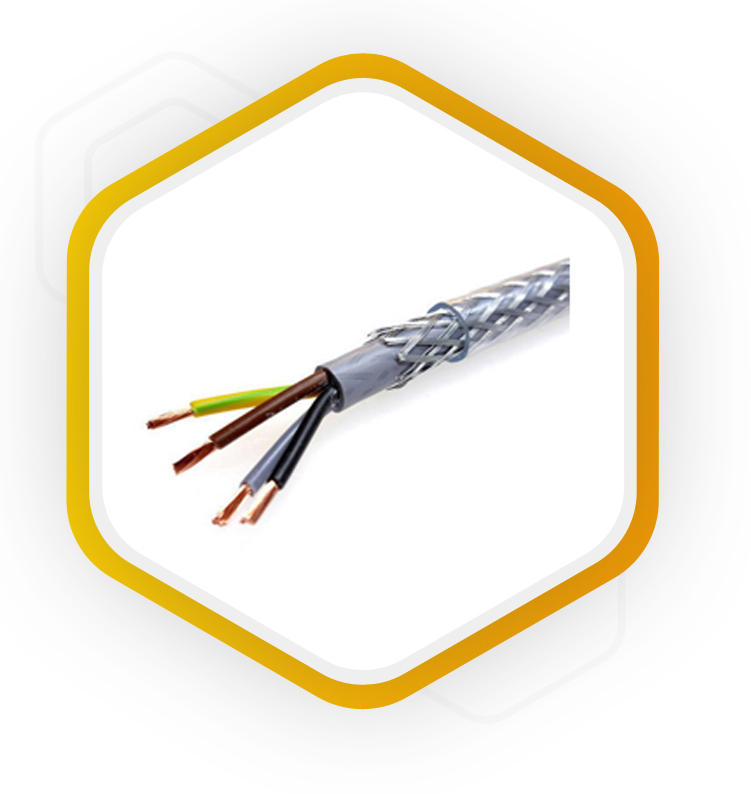Screened Cables

We also Manufacture variety of cables like Fire Alarm Cables, Fire Survival Cables, Instrumentation Cables, Control Cables, Signal Cables, Screened Cables & Multicore Flexible Cables.
SRI PADMAVATHI CABLES, an ISO 9001: 2015 certified, MSME & GeM ( Govt. e-Market) registered company associated with manufacturing and marketing "SPCWIRREEz" Brand as per IS, BS & IEC Standards. Copper Conductor PVC/XLPE/PE Insulated Electrical Cables and wires. Voltage grade up to 300 / 600 V.
Screened Cables, also known as Shielded cables, are electrical cables that have a conductive layer (shield) around the inner conductors. This shielding helps to protect the cable from electromagnetic interference (EMI), ensuring signal integrity and reducing noise.
Features of Screened Cables :
Screened cables, also known as shielded cables, are designed to reduce electromagnetic interference (EMI) and protect signal integrity.
-
Shielding Material : Uses metallic shielding (e.g., aluminum foil, braided copper, or a combination) to prevent EMI. Reduces crosstalk between cables and external interference.
-
Enhanced Signal Integrity : Ensures stable signal transmission with minimal loss or distortion. Ideal for sensitive communication and data cables.
-
Protection Against External Noise : Blocks electromagnetic and radio frequency interference (RFI). Suitable for environments with high electrical noise (e.g., industrial sites, power plants).
-
Different Shielding Types:
» Foil Shielding : Thin aluminum or copper foil provides 100% coverage.
» Braided Shielding : Woven copper or aluminum strands offer durability and flexibility.
» Combination Shielding : Uses both foil and braid for enhanced protection.
-
Multiple Applications : Used in data transmission, audio/video systems, industrial automation, and power distribution. Common in networking, medical equipment, and aerospace industries.
-
Improved Safety & Durability : Protects against voltage spikes and reduces signal leakage. Increases cable lifespan, especially in harsh environments.
-
Grounding Requirement : Requires proper grounding to function effectively. Improper grounding may lead to performance issues or increased EMI.
Applications of Screened Cables :
Screened cables, also known as shielded cables, are used in various applications to reduce electromagnetic interference (EMI) and radio frequency interference (RFI). Here are some key applications:
-
Industrial Automation : Used in control systems to prevent interference from motors and high-power equipment. Prevents signal interference in high-electromagnetic environments like factories. Ensures stable communication between sensors, actuators, and control units.
-
Audio & Video Systems : Reduces noise in microphones, speakers, and communication systems. Common in home theater systems and recording studios for high-fidelity signal transmission.
-
Data Transmission : Used in Ethernet, coaxial, and instrumentation cables for signal clarity. Essential in high-speed data transmission networks to reduce crosstalk and external interference.
-
Medical Equipment : Used in sensitive medical devices like ECG, MRI, and ultrasound machines to avoid interference from external electronic sources. Ensures accurate readings and reliable operation in hospitals and diagnostic centers.
-
Power and Electrical Systems : Used in power cables to minimize interference in nearby circuits. Common in renewable energy systems (solar farms, wind turbines) to ensure reliable signal transmission.
-
Railway and Metro Systems : Used in signaling and communication networks to ensure reliable data transfer in high-EMI environments. Prevents disruptions in train control and monitoring systems.
-
Oil and Gas Industry : Used in hazardous environments with high electromagnetic activity, such as drilling rigs and refineries. Protects control and monitoring systems from interference.
Signal Cables application industries :
Signal cables are used in various industries for transmitting data, control signals, and communication between devices.
Key industries where signal cables are commonly applied :
-
Telecommunications : Used for data transmission, networking, and telephony. Fiber optic and coaxial cables are widely used for high-speed communication.
-
Industrial Automation : Used in control systems, PLCs, SCADA systems, and sensors. Helps in real-time monitoring and process automation.
-
Power Generation & Distribution : Used in substations, power plants, and renewable energy installations. Transmit control signals for switchgear and monitoring equipment.
-
Automotive & Transportation : Used in vehicle communication systems, GPS, and entertainment systems. Essential for sensor connections in electric vehicles (EVs) and smart transport systems.
-
Aerospace & Defense : Used in avionics, communication, and radar systems. Designed to withstand extreme temperatures, vibrations, and electromagnetic interference.
-
Medical & Healthcare : Used in medical imaging, diagnostic equipment, and patient monitoring systems. High precision and low noise cables for critical applications like MRI and ultrasound machines.
-
Oil & Gas : Used for data transmission in drilling operations and pipeline monitoring. Designed for harsh environments with high temperatures and corrosive conditions.
-
Building & Construction : Used in fire alarm systems, security systems, and HVAC control. Essential for smart building automation and IoT applications.
-
Consumer Electronics : Used in audio/video systems, home automation, and gaming consoles. HDMI, USB, and auxiliary cables are common examples.
-
Railway & Metro Systems : Used for signaling, communication, and control systems. Ensures smooth operation and safety in transportation networks.